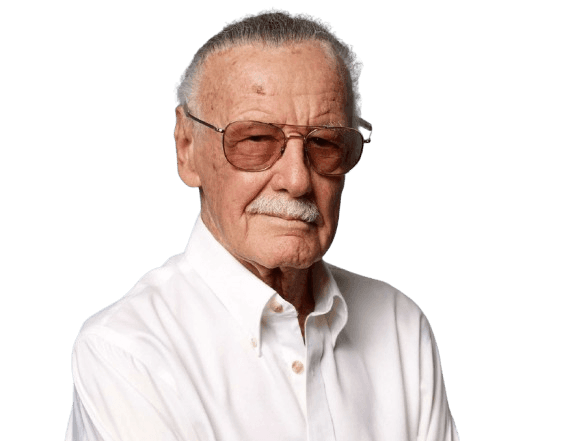Life and achievements
Early life
Stanley Martin Lieber was born on December 28, 1922, in Manhattan, New York City, to Jewish Romanian immigrants Celia and Jack Lieber. He experienced financial difficulties as a child, and his family relocated to Washington Heights during the Great Depression. Lee had always been an avid reader and writer and was fond of heroes and other such characters from the books and movies he watched, especially those portrayed by Errol Flynn.
Lee's father was a dress cutter who often lost his job, which affected the family's living standard. However, he had to face many problems; however, he sought comfort in reading books and writing, and the idea of writing the Great American Novel. Some of his first writing assignments were writing obituaries and press releases, which showed his potential. Lee went to DeWitt Clinton High School in the Bronx, New York, continued to polish his writing skills, and participated in a high school essay competition, which interested him in professional writing.
In 1939, Lee got a job at Timely Comics, a company that would later become Marvel Comics, with the assistance of his uncle Robbie Solomon. This job was his first job in the comic book industry and was the beginning of his career. He began doing odd jobs and gradually moved up; he wrote his first comic book text filler in 1941. In his early years, Lee was full of energy and ideas, which provided a good foundation for his future achievements.
Legacy
Stan Lee is one of the most influential and famous people who left a significant impact not only on the world of comic books. He co-created some of the most popular and loved characters in comics and movies, including Spiderman, X-Men, Ironman, Thor, Hulk, and Fantastic Four. These characters not only changed the face of comic books but also shaped the movie, television, and the entire pop culture. Lee was instrumental in developing Marvel, and his creative mind helped turn the company into a media mogul.
This is evident in the MCU, which has become one of the highest-grossing film franchises ever. His characters have won the hearts of millions of people and other writers, which proves the timelessness of the author's creativity. Lee's storytelling brought multi-dimensional and imperfect protagonists who faced tangible problems to the masses, and thus, they were easily recognizable by readers of any age.
Besides the work that he has produced, Lee's influence extends to his position as a public representative of the comic book medium. He was a popular individual famous for his energy and passion. He was often seen in public and featured in Marvel movies. Lee was honoured with many awards during his career; he was inducted into the Will Eisner Award Hall of Fame and the Jack Kirby Hall of Fame and was awarded the National Medal of Arts.
His philanthropic activities through the Stan Lee Foundation were also towards literacy, education, and arts, thus making him a philanthropist. Although Lee struggled with legal issues and personal issues in the last decades of his life, he did not stop working and creating until he died in 2018. His work will be remembered for decades, and the comic book community and fans will miss him.
Milestone moments
Dec 19, 1941
First Published Work
Stan Lee's first piece of work was a text piece titled 'Captain America Foils the Traitor's Revenge' in Captain America Comics #3. This was the start of his writing career as a comic book writer. Lee adopted the pen name Stan Lee for the first time, and the name would go on to define comic book greatness. This first story also featured the classic Cap shield-bounce, where he throws his shield and bounces off things.
Mar 19, 1961
Origin of the Fantastic Four
The Fantastic Four is the first superhero team of Marvel Comics and was created by Stan Lee and Jack Kirby in The Fantastic Four #1. This series was a huge success and formed the basis for Marvel's comics in the 1960s. The characters of the Fantastic Four and the plots of the comics were more realistic than the earlier superhero comics, thus changing the course of the comic book industry. This was the start of Marvel's dominance in the comic book industry; previously, DC had dominated.
Aug 19, 1962
Introduction of Spiderman
Spiderman first appeared in the comic book named Amazing Fantasy #15 and was created by Stan Lee and Steve Ditko. The character quickly rose to the rank of one of the most popular and recognizable heroes of the Marvel universe. Spiderman's Spiderman's everyday problems and extraordinary abilities were easy for readers to identify. Thus, the character became famous. This milestone reinforced Lee as a great storyteller and as a creative genius.
Jan 8, 1971
Busting the Comics Code Authority
Stan Lee wrote a three-part story arc in The Amazing Spiderman #96-98 to raise awareness of the effects of drug abuse. Ignoring the Comics Code Authority's ban on the issues, Lee and Marvel released the problems anyway. This positive response brought about changes in the Comics Code, which thus paved the way for the emergence of more adult and realistic themes in the world of comics. This milestone showed that Lee is fearless in breaking the norms and tackling real-life societal issues.
